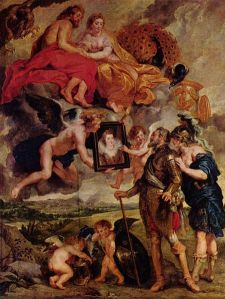I didn’t think I liked Rubens – melodrama, Counter-Reformation, acres of female flesh – until I visited his house in Antwerp. This was achieved after a horrendous journey by car from Brussels: Belgian drivers are even worse than the French (though you’d think that wasn’t possible), and the road itself was so badly grooved that we were quite positive at one point that the car steering had failed. Consequently, I was prepared to like anything at all that didn’t involve vehicular motion, and was greatly restored by a tour of the Plantin-Moretus House (what a shame that Venice doesn’t have an equivalent memorial to Aldus Manutius rather than this disregarded plaque).
But Rubens’ house was a revelation, not only of his skill as a painter of serene and beautiful landscapes, but also of his life as a well-to-do paterfamilias, and his extraordinary industry.
The exhibition currently running at the Royal Academy confirmed these impressions (though it was not short – under the headings of ‘Violence’ and ‘Lust’ – of the aforementioned flesh). It opens not with Rubens, but with John Constable‘s ‘Cottage at East Bergholt’, a pastoral landscape with a rainbow, clearly influenced by the Flemish landscapes he would have seen at the home of his patron and at the Royal Academy Schools. A wooded landscape in the Forest of Bere by Turner shows a similar influence.
The theme of the exhibition is the legacy – from Van Dyke (Rubens’ most famous pupil) to Cezanne, via all sorts of people, some of whose ‘influenced’ work is less successful than that of others. (A bathetic note is struck by the ‘Gallery Guide’ leaflet: a room is devoted to the response of Jenny Saville RA to the works on display, bringing together ‘artists from Picasso to the present day’. The guide states: ‘The Flemish master even stands comparison with Andy Warhol.’ This is either a genuine misunderstanding of what the phrase ‘stands comparison with’ means, or the worst piece of art criticism since Ruskin on Whistler.)
In my ‘don’t like Rubens’ days, I was given pause by the fact that the great and good Sir Joshua Reynolds thought he was wonderful (at least in his use of colour) and examines many of his works in detail in the ‘Journey to Flanders and Holland‘. His influence on the portraiture of Reynolds, Gainsborough and Lawrence is convincingly demonstrated, and I was especially intrigued to learn that Elisabeth Vigée Le Brun‘s famous self-portrait in a straw hat is a descendant of Rubens’ equally famous portrait of his wife.
Vigée Le Brun is supposed to have scandalised pre-Revolutionary French court circles by the informality of her portraits, in which the sitters (shock horror) are caught smiling, with Visible Teeth. Given that she was favourite of Marie Antoinette, and her works encouraged the ‘shepherdess’ fad, it is remarkable that she escaped the guillotine: her memoirs as a travelling professional artist, mother and wife are a fascinating read.
Another section of the exhibition revealed a whole cycle of paintings, made at the behest of Marie de Medicis to celebrate her all-over wonderfulness, and originally part of the decor of the palace of the Luxembourg (now in the Louvre). The final versions are displayed digitally, and there are some preliminary sketches on display. They are not dissimilar in tone to the apotheosis of James I in the Whitehall Banqueting House, and forcefully recall that Rubens’ other job was as a diplomat: it must have been a tightrope act to deliver scenes such as that of the princess’s education by the Three Graces (among others) or of the rapture with which Henri IV is seen receiving a portrait of his proposed wife.
I can thoroughly recommend this exhibition (though it closes next week!) for insights, connections, and thought-provoking trains of thought – and there’s even a theoretical justification for the acres of flesh!
Caroline







Pingback: Plantin and Moretus | Professor Hedgehog's Journal
Pingback: Object of the Month: June 2017 | Professor Hedgehog's Journal
Pingback: Cats in Art | Professor Hedgehog's Journal
Pingback: Titian to Rubens | Professor Hedgehog's Journal